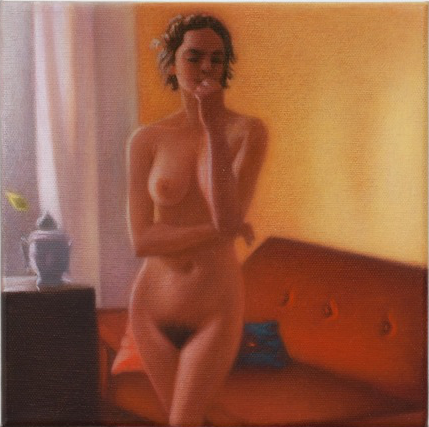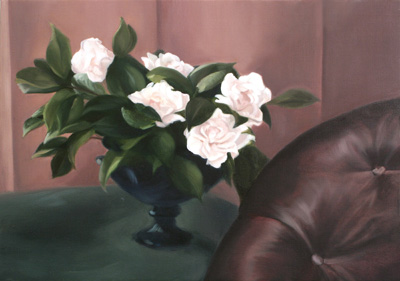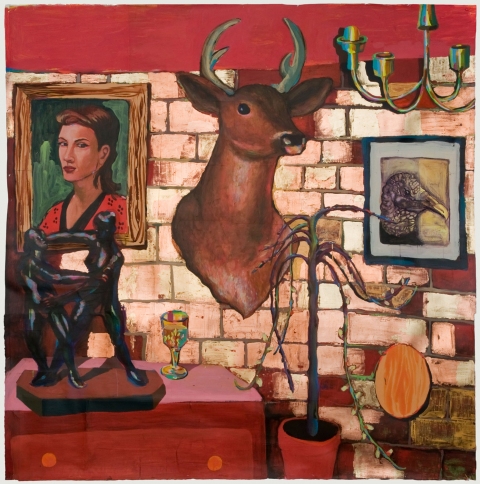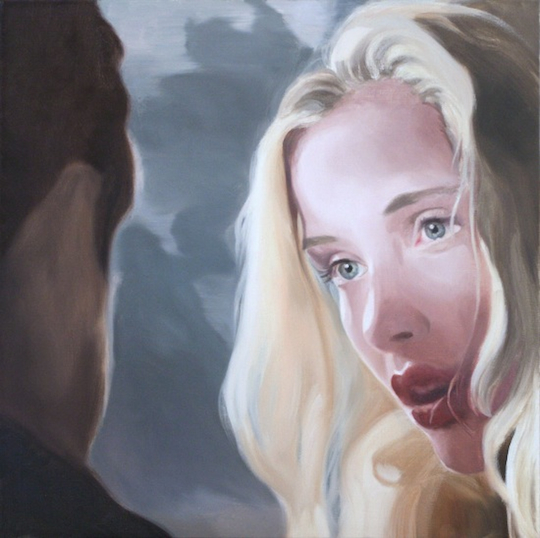The four person exhibition at Sargent’s Daughters on the Lower East Side finds equilibrium between personal and private, wherein the private is paradoxically exposed to the public realm and thus subverted. What is normally hidden behind closed doors is exposed, in a contemporary re-molding of a history of painting with a rich tradition of putting the private on display. The conversation going on between the artists at Sargent’s Daughters is one of living room intimacy between friends, and the cohesiveness of four distinct visions in the gallery’s space invites viewers to slip onto the couch and listen in on the conversation. There’s an element of being at-home in the gallery, but what is said in paint is said louder by what lies just outside the frames’ edges. If there’s one thing that speaks to the cohesiveness of the four artists’ simultaneous visions, it’s an ability to invigorate their work with the possibility of the futural moment. In other words, it’s what’s not seen on the canvas that fuels the dialogue; it’s the interior dialogue of the works themselves, and not just the artists behind their creation, that give even the stillest of moments unstoppable momentum towards the future. The press release to the show tells us: “The tradition of depicting an inside space is one that has allowed us access to details of everyday life- Pietro Longhi’s scenes of Venetian pastimes and games; Van Gogh’s study of his bedroom; Matisse’s The Red Studio; Vermeer’s intricate scenes of Dutch life all portray a world away from the world.”[1] Matvey Levenstein’s “Woman in Interior” (2010) could be seen as a classic nude, but its small size (8×8 inches) and the carelessness of the woman’s expression— a woman aware of the artist’s presence— makes the female form strikingly contemporary. The casual way in which she holds her finger up to her mouth, the way her elbow rests on the right wrist, tells the viewer that she hasn’t been holding this pose for long. She was in between words, or thoughts, and the viewer knows that she moved out of her pose just as quickly as she came into it. The fleetingness of the moment makes the painting feel like it was a photograph, situating the piece in a context wherein photography as an artform was possible.
Like many of the other works on view, the background is simple enough to be placed in a historical context ranging anywhere from the 1700’s to yesterday. It’s the ambiguity of historical contextualization which liberates the exhibition as a whole from being relegated to a sort of homage to European painting traditions. Sarah Kurz’ “We Laughed and Laughed and Laughed” (2013) is a still life whose title leaves the main players out of the story: the audience is free to imagine both who was doing the laughing and what they were laughing about, without being tied to a specific time period. What looks like the back of a Victorian leather chair could easily be a futon. Again, we don’t know where we are, but the fear of not knowing is displaced by the freedom to self-contextualize. Karen Heagle’s “Let Nature Take Its Course and Hope it Passes” (2011) evokes a similar feeling of freedom found in the suspension of time. One has the feeling that Heagle was stuck inside during a snowstorm when she captured this moment, forced to take a hard look at her surroundings while nature ran its course outside the walls. Other than a string of artificial lights hanging off a leafless tree, nothing in the image gives way to its conceptualization as having must have happened recently, at least after the advent of string lights. In another work by Heagle, it’s the lava lamp in the corner that begs our mind to situate us in a modern historical time period otherwise hidden by the French country kitchen of an anonymous time.
Interior Dialogue is both a glimpse into the private worlds of the artists in dialogue and a living room conversation that invites anyone who walks through the door to sit for tea. It’s a place where no answer is the wrong answer, and no question is a bad question. Karen Heagle, Lonnie Holley, Sarah Kurz, and Matvey Levenstein create this ambivalence and openness in their work to invite just this kind of discussion of time and place.
Interior Dialogue is on view at Sargent’s Daughters Gallery at 179 East Broadway through February 23rd. For gallery hours and further information, visit http://sargentsdaughters.com/.
– Amie Zimmer
All images courtesy of Sargent’s Daughters Gallery
[1] http://prod-images.exhibit-e.com/templates_exhibit-e_com/Interior_Dialogue___Press_Release.pdf






























